Out-of-home (OOH) advertising remains a powerful medium to capture attention in today’s fast-paced world. With the right blend of creativity and strategy, OOH campaigns can leave lasting impressions. Here are ten effective OOH advertising ideas that have proven successful:
1. Interactive Digital Signage
Transform traditional billboards into engaging experiences by incorporating interactive digital signage. These displays invite consumers to actively participate with the content, fostering deeper connections with the brand. For instance, touchscreens or motion sensors can be used to create immersive experiences.
Case Study 1: Campaign for Dancing with the Stars Australia encouraged passers-by to press a button on the digital billboard and join in by following an interactive dance tutorial displayed on the screen
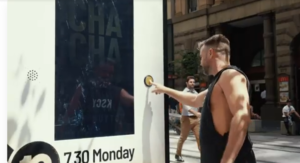

Case Study 2: Gymshark Unveils the Shoplift Campaign Ahead of Sale
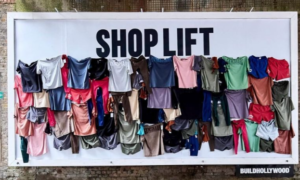
Case Study 3: Netflix’s Daredevil campaign used an interactive billboard in Toronto where fans voted for their favorite character via Twitter, triggering real-time visual “battles” on the display
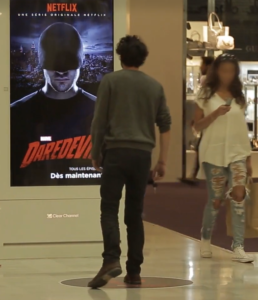
Case Study 4: Reebok’s Speed Test Campaign. Interactive Billboard that detects running speed

Case Study 5: KitKat’s Have a Break Campaign – Vibration enabled screen, user stands touching the screen & gets a massage
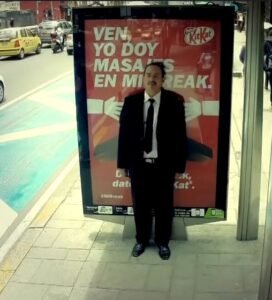
2. 3D Billboards
Adding three-dimensional elements to billboards creates a striking visual impact. These ads break the monotony of flat images, making them more noticeable and memorable. For example, a beverage company might design a billboard with a bottle seemingly protruding outwards, enticing viewers.
Case Study: Nike’s 3D Air Max billboard in Tokyo showed the shoe floating mid-air with light effects.

3. Environmental Integration
Seamlessly blending advertisements with the surrounding environment can enhance their effectiveness. This approach, known as environmental integration, ensures that the ad complements its setting, making it more relatable and less intrusive. For example, painting a crosswalk to resemble a product or using existing structures as part of the ad design.
Case Study: Mr. Clean’s zebra crossing ad painted one stripe ultra-white, subtly showing off the product.

4. Light Projection Advertising
Utilizing light projections on buildings or other surfaces can create dynamic and eye-catching displays. This method allows for flexibility, as content can be changed easily, and it can turn ordinary structures into captivating visual experiences during nighttime.
Case Study: Projection on to building aimed to “raise a smile”

5. Creative Bus Shelter Ads
Bus shelters offer a captive audience and can be transformed into interactive or thematic brand experiences. Incorporating functional elements, such as heating during winter for a clothing brand, or creating immersive environments that reflect the brand’s message, can engage commuters effectively.
Case Study: Pepsi’s AR bus shelter in London added aliens and UFOs into real-time video feed, creating viral buzz.
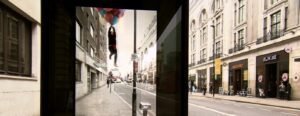
6. Mobile Billboards
Advertising on vehicles, such as trucks or buses, ensures that the message reaches a wider and more diverse audience. These moving ads can be strategically routed through high-traffic areas or specific neighborhoods to target desired demographics.
Case Study: Spotify used wrapped trucks to promote personalized playlists in NYC, driving social shares.

7. Augmented Reality Experiences
Incorporating augmented reality (AR) into OOH advertising allows consumers to interact with ads using their smartphones. By scanning a QR code or using an app, users can unlock additional content, games, or virtual try-ons, bridging the gap between physical and digital advertising.
Case Study: Burger King’s “Burn That Ad” let users digitally burn competitors’ ads via AR.

8. Pop-Up Installations
Temporary installations or pop-up experiences in public spaces can generate buzz and provide direct engagement with the brand. These setups can offer product samples, demonstrations, or immersive experiences that leave a lasting impression on attendees.
Case Study: Adidas built a “D Rose Jump Store” in London where kids could win shoes by jumping 10 feet high.
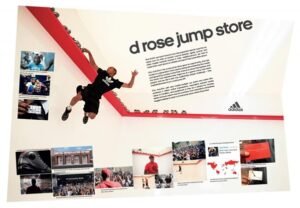
9. Eco-Friendly Advertisements
Utilizing sustainable materials or promoting environmental messages resonates with eco-conscious consumers. For instance, creating billboards from recycled materials or integrating live plants into the design not only captures attention but also showcases the brand’s commitment to sustainability
Case Study: Coca-Cola’s living plant billboard in the Philippines absorbed pollution while promoting their brand.
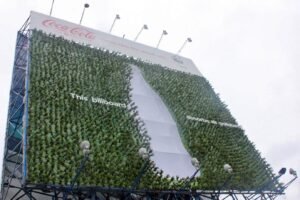
10. Guerilla Marketing Tactics
Unconventional and often low-cost, guerilla marketing involves placing unexpected ads in unexpected places. This could include sidewalk chalk art, stickers in urban areas, or flash mobs. The element of surprise and creativity can lead to viral marketing success.
Incorporating these innovative OOH advertising strategies can significantly enhance brand visibility and engagement. By thinking outside the box and leveraging the environment and technology, advertisers can create memorable campaigns that resonate with their target audiences.
Case Study: The “It” movie campaign in Sydney placed red balloons tied to sewer grates, terrifying and thrilling passersby

💬 10 FAQs on OOH (Out-of-Home) Advertising Ideas
Q1. What is Out-of-Home (OOH) advertising?
A: OOH advertising refers to any form of marketing that reaches consumers while they are outside their homes. It includes billboards, transit ads, digital screens, and street installations. These formats build high brand recall and deliver large-scale visibility in public spaces.
Q2. Why is OOH advertising still effective in the digital age?
A: Despite the rise of digital media, OOH advertising remains powerful because it offers unskippable, real-world visibility. Modern OOH integrates with digital tools such as QR codes, AR, and social media hashtags, bridging offline exposure with online engagement.
Q3. What are some of the most innovative OOH advertising ideas?
A: Innovative ideas include interactive digital signage, 3D billboards, augmented reality experiences, eco-friendly plant billboards, and projection mapping on buildings. These approaches capture attention through technology, creativity, and contextual relevance.
Q4. How does interactive digital signage enhance audience engagement?
A: Interactive digital signage allows passers-by to participate with the ad using touchscreens, motion sensors, or live social integration. This interactivity fosters deeper emotional connections and can increase campaign recall and social sharing.
Q5. What makes 3D billboards so impactful?
A: 3D billboards stand out due to their visual depth and realism, creating the illusion that objects are emerging from the screen. This immersive experience helps brands achieve instant attention and virality, especially when amplified on social media.
Q6. What are examples of environmentally friendly OOH advertising?
A: Eco-friendly OOH campaigns use recycled materials, solar energy, or live plants within billboards. These sustainable ads not only reduce environmental impact but also align with brands promoting green values and social responsibility.
Q7. How can augmented reality (AR) be used in outdoor advertising?
A: AR in OOH allows audiences to scan a QR code or use a mobile app to unlock virtual experiences, games, or product try-ons. It merges digital engagement with physical spaces, making campaigns more interactive and measurable.
Q8. What are the advantages of mobile and transit billboards?
A: Mobile billboards, such as ads on trucks or buses, deliver flexible, wide-ranging exposure across multiple neighborhoods. They are cost-effective for targeting specific routes and ensuring repeated impressions among daily commuters.
Q9. How do pop-up installations benefit brand campaigns?
A: Pop-up installations create temporary, immersive experiences where people can engage directly with a brand. They generate buzz, encourage content creation, and allow potential customers to experience the product firsthand in an exciting, real-world setting.
Q10. What is guerilla marketing in OOH advertising?
A: Guerilla marketing uses unexpected, low-cost, and highly creative tactics in public spaces — such as chalk art, flash mobs, or surprising installations. Its spontaneity and shareability help brands go viral and reach audiences beyond traditional advertising.

